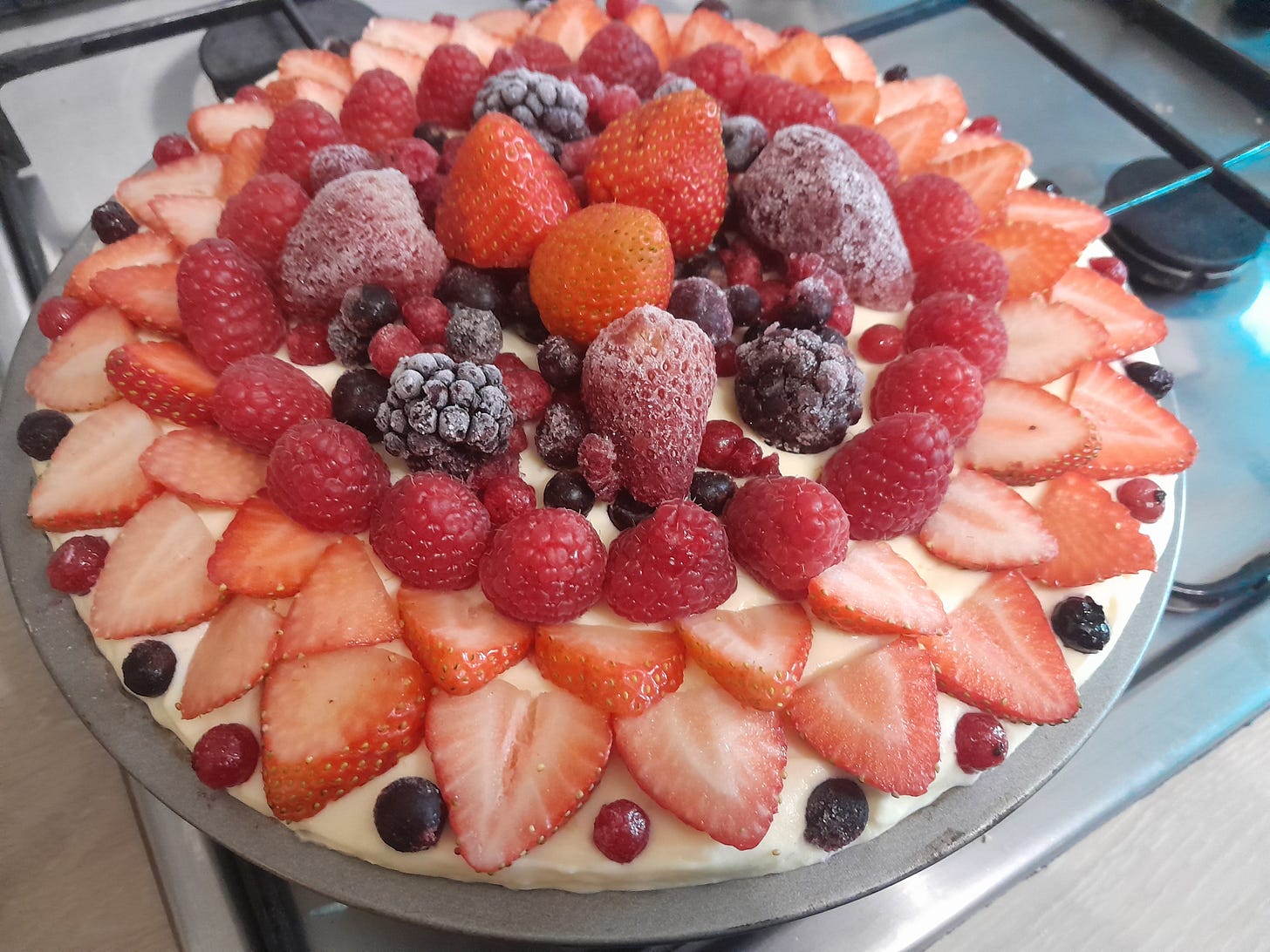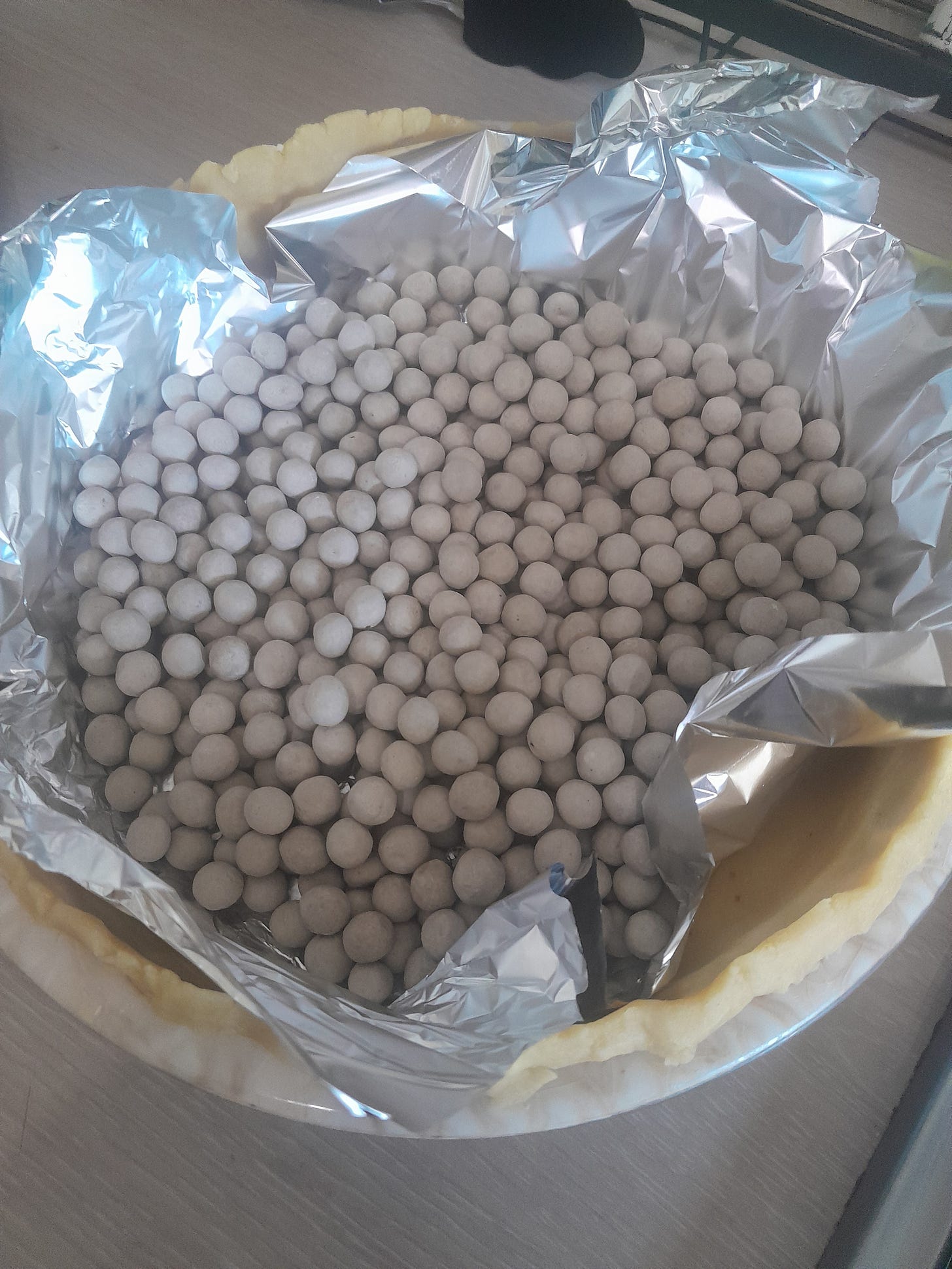
It’s summer. The sun is out, temperatures are rising, and Donald John Trump is a convicted felon. I think we need to celebrate.
I’m giving you a double recipe today, two versatile recipes which are perfect for summer parties or a light lunch. Both are classic dishes that reached the peak of their popularity in the 1970s and, I feel, are overdue to make a dramatic comeback.
Recipe #1: A Quiche!
First up, you have the humble quiche. Widely believed to have originated in France due to the popularity of Quiche Lorraine, this lunchtime staple actually originated in the German kingdom of Lothringen during the Medieval period. It made its way into France when the French invaded Lothringen during the prolific warring of the Middle Ages. The French changed the name of the dish to Quiche Lorraine, and that’s how it became known the world over.
A good quiche requires a rich pastry base, and a filling made from beaten eggs, milk or cream, and a good, strong cheese. The other fillings can be anything you have lying around and think would go well together. Today, I’m filling mine with roasted red peppers, red onions, feta cheese, and pesto.
This quiche will serve eight, with a carbohydrate count of 25.8g per portion, or 206.4g for the whole thing.
Your Equipment
Digital kitchen scales
Large bowl or food processor
Rolling pin
Pie dish
Baking beads, dried lentils or uncooked rice
Aluminum kitchen foil
Sharp kitchen knife
Measuring spoons
Your Ingredients

For the pastry:
175 g all purpose flour
½ tsp salt
100 g butter, cut into ½ inch cubes
1 egg yolk
4 tsp cold water
For the filling:
3 eggs, beaten
200 ml full fat milk
200 ml natural yogurt or crème fraiche
100 g strong cheese (I used extra mature cheddar)
200 g feta
2 red peppers, roasted, peeled and deseeded, cut into strips
1 red onion, thinly sliced
8 tsp pesto
The important bit…
First up is your pastry. You can do this in one of two ways:
Option 1: Place your flour, butter and salt into your large mixing bowl and rub them together using your fingertips until the mix looks like breadcrumbs.
Add your egg yolk and water and mix together until it forms a smooth dough. You can use your hands to mix, but I recommend using the blade of a butter knife as you’re best to avoid overhandling your pastry.
OR! Option 2: Simply put all your pastry ingredients into a food processor and pulse until they form a smooth dough.
Next!
Lightly flour your work surface, tip out your pastry dough, and bring it together to form a smooth ball. Now roll it out as thinly as possible, ideally no thicker than a 50 cent coin. [Rebecca here: I don’t know what a 50 cent coin is either, and if Nicola means a regular US fifty-cent-piece, I don’t believe I’ve ever seen one, but I assume you are trying to get it *very thin*.]
Carefully lift your pastry using the rolling pin, and lay it onto your pie dish. Gently push it into the edges of the dish and trim the excess to just above the top of the dish. Use the trimmings to repair any cracks or rips that have formed. Gently prick the bottom of the pastry case with a fork, and chill in the fridge for at least 10 minutes.
Preheat your oven to 390F. Take your pastry case from the fridge and line it with a sheet of aluminum foil, then fill it with baking beans, dried lentils, or uncooked rice. Place the pastry case into the oven, and bake for 15 minutes.
Remove the baking beads and foil and return the pastry case to the oven for another 5 minutes, or until the pastry is a light golden colour.
Remove from the oven and set aside to cool whilst you make your filling.
Gently fry your onion in a tbsp of sunflower oil until it starts to turn brown.
In a jug, combine your beaten egg, milk, and yoghurt. Mix well and season with plenty of freshly ground black pepper.
Lay roughly half the onions across the bottom of your pastry case. Add roughly half of the roasted red peppers, cheddar, and feta. Spoon in 4 tsps of pesto. Repeat with the rest of the onions, peppers, feta, and more pesto. Save the rest of the cheddar for later.
Pour in your egg mixture.
Sprinkle the remaining cheddar across the top of your quiche.
Reduce your oven temperature to 340F. Place your quiche into the oven and bake for 45 minutes, or until the filling has set and the cheese on top begins to brown.
Allow to cool before serving. This would be lovely with a nice bistro salad and some crusty bread. That’s how I’ll be serving it at lunchtime tomorrow.

If you want to make this recipe healthier, swap the shortcrust pastry for 4 sheets of filo pastry, lightly brushed with oil and laid at 45 degree angles to each other. Skip the blind baking bit and just pop it in the oven for 45 minutes. You can also use half fat cheese, and reduced fat milk and natural yoghurt.
Recipe #2: It’s Flan!
Since we’re celebrating, we need a dessert to go with this celebratory lunch. We’re heading back to the 1970s again with a classic fruit flan, a delicious, colourful dessert that is not that difficult to make, and is hugely overdue to make a comeback.
The flan has a very long history, it’s been around since the early days of the Roman empire, when surplus eggs were used to make both sweet and savoury custards. The Spanish took it with them to America, where it evolved into crème caramel. In Europe a different variation evolved where a sweet pastry or sponge case was filled with fruit and custard or jelly (jello). It’s this variation that was all the craze during the ‘70s, and I have fond memories of eating a sponge flan filled with tinned peaches and strawberry jelly, served with condensed milk, on visits to my grandmother’s house as a youngster. Grandmother was born in 1938. She grew up during the years of ration books, eating the foods that gave the rest of the world their outdated idea of what British food is, so a sponge flan base with tinned peaches and strawberry jelly was the height of indulgence for her.
For this recipe, I’m going to elevate grandma’s humble sponge flan. Instead of tinned fruit and jelly, or custard, I’m going with a crème diplomate filling, topped with summer fruits, combining my nostalgia with French patisserie.
One flan will serve 8, more if you’re not feeling particularly generous. Your carbohydrates are 41g per portion, or 328g for the entire flan.
Your equipment
Large heatproof mixing bowl
Medium pan, ½ full of water, brought to a simmer
Electric whisk
Wooden spoon
9 inch fluted flan dish
Saucepan
Medium sized mixing bowl
Whisk
Stand mixer or second medium mixing bowl
Your ingredients

For the sponge base:
85 g all purpose flour
85 g sugar
3 eggs
2 tbsp strawberry jelly (jam)
For the crème diplomate:
500 ml full fat milk
2 tsp vanilla paste
60 g sugar
30 g corn starch
2 leaves gelatine / 7g gelatine powder
180 ml heavy cream (do not use a reduced fat cream, it won’t whip well enough)
For the topping:
200 g fresh strawberries
100 g fresh raspberries
150 g summer fruits mix (I used a frozen mix as my local grocery store didn’t have fresh blackberries)
… Or fruits of your choosing (this will change the carbohydrates for the recipe).
The important bit…
First up, you’ll need to make your flan base. Preheat your oven to 350F and grease your flan tin, a bit of spray oil works perfectly for this.
Get your pan of water on your stove on a low heat so it’s just simmering. In your heatproof bowl, combine your 3 eggs and 85 g sugar. Place your heatproof bowl on top of your pan of hot water, and use your electric whisk to whisk the egg and sugar mixture until it is thick and fluffy looking. This should take around 5 minutes.
Remove from the heat and fold through the 85 g of flour, being careful not to knock the air out of the mixture. I find the best way to do this is to gently stir the mixture in a figure of eight motion.
Once your mixture is smooth, pour it into your flan dish and bake in the oven for 15-20 minutes. You’re looking for a golden sponge which springs back into shape when gently pressed.
Mix the 2 tbsp of strawberry jelly/jam with 1 tsp of boiling water and give it a good stir. Use this to glaze your sponge base.
Leave your sponge base to cool whilst you make your crème diplomate.
In your saucepan, combine your milk and vanilla paste and bring to a simmer on a low heat.
In your medium mixing bowl, combine your 4 egg yolks with the 60g sugar and 30g corn starch and whisk until a smooth paste is formed.
Once your milk is simmering, remove it from the heat and gently pour it into your egg mixture, you need to keep whisking whilst you do this.
Return the milk and egg mixture to the pan and place back on a low heat. Keep whisking. This is your crème patisserie, the first component of a crème diplomate.
The crème patisserie should start to thicken up fairly quickly. Once it starts to boil, keep whisking for 30 seconds and then remove from the heat and set aside.
Soak your gelatine in a little cold water, 2 tbsp should be enough, and leave until it blooms. Now add the gelatine into your warm crème patisserie and whisk thoroughly until smooth. Place in the fridge to chill for around an hour and a half whilst you enjoy a welcome break, a little Wonkette, and the refreshing taste of fresh MAGA tears.
Take your heavy cream and place it into your stand mixer or second medium mixing bowl. Whip it until it forms stiff peaks.
Remove your crème patisserie from the fridge and give it a quick whisk to loosen it up.
Add your whipped cream to the crème patisserie and fold into the mix using a wooden spoon. It should combine to form a smooth, light crème diplomate.
Take your sponge base and spread the crème diplomate in a layer over the top. Place in the fridge to chill for at least 10 minutes, then artfully arrange your fruit over the top.
Serve with a chilled glass of prosecco and some good friends to share it with.
See you next month!
*Caution, ad shaped objects*
For any baking equipment and hard to find ingredients, this here Amazon linky could be handy, and it helps Trix pay for your cakes.
If you’re not feeling up to baking, you could always use this here linky for Martie to purchase your snacks (Wonkette cut link). You’d be helping to keep Your Wonkette funded and save delicious snacks from ending up in landfill, and it saves you money — so much winning!












Here's fun - a list of countries that deny entry to felons: https://people.com/donald-trump-barred-entering-37-countries-convicted-felon-8657038
Includes the UK (no more Scottish golf for you, Felonious Stunk) and Canada and ... Mexico.
So if he goes to Mexico, he's an illegal.
Y'all will be sad (nope) to know that no one (at least within my hearing) was talking about the felon, and when the service started our pastor said a special prayer for Haiti, not for the felon. Even in South Carolina, some people are more concerned with people who are in real trouble through no fault of their own, and not the the felon, who is in trouble, but it's his own damn fault.